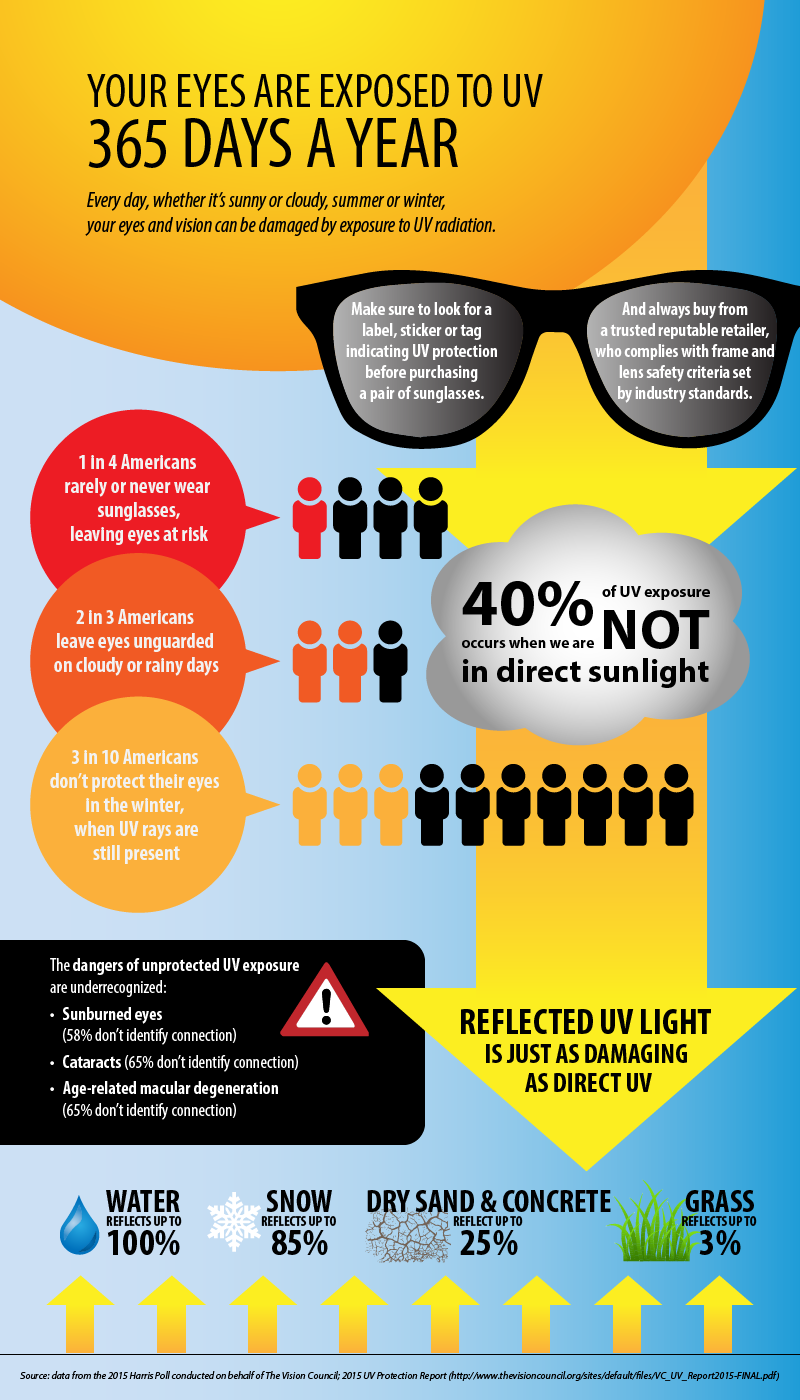Protect Your Eyes from UV Radiation
Even as summer comes to an end, it’s important to continue to protect your eyes from UV radiation year-round. The sun emits energy over a broad spectrum of wavelengths: visible light that you see, infrared radiation that you feel as heat, and ultraviolet (UV) radiation that you can’t see or feel. Many people are aware of the sun’s harmful effects on the skin, but many do not realize that exposure to UV radiation can also be harmful to the eyes and vision. And our eyes are not just at risk during the summer months. Every day, whether it’s sunny or cloudy, summer or winter, our eyes and vision can be damaged by exposure to UV radiation. 40 percent of UV exposure occurs when we are not in full sunlight. Furthermore, reflected UV is just as damaging, increases exposure, and doubles your risk in certain conditions like water or snow — for instance, water reflects up to 100% of UV light and snow reflects up to 85% of UV light.

What is UV Radiation?
Light with a wavelength less than 400 nm (nanometers) is defined as UV radiation and are classified into three types or bands — UVA, UVB and UVC.
- UVC: Wavelength: 100-279 nm. Completely absorbed by the ozone layer and does not present any threat.
- UVB: Wavelength: 280-314 nm. Only partially blocked by the ozone layer and can burn the skin and eyes causing both short- and long-term effects on the eyes and vision.
- UVA: Wavelength: 315-399 nm. Not absorbed by the ozone layer and cause the most damage to eye and vision health.
While sunlight is the main source of UV radiation, tanning lamps and beds are also sources of UV radiation.
Why Do Your Eyes Need Daily UV Protection?
UV radiation can seriously damage your eyes. There is no amount of UV radiation exposure that is healthy for your eyes.
For instance, if your eyes are exposed to excessive amounts of UVB radiation over a short period of time, you may experience photokeratitis. Similar to a “sunburn of the eye,” you may not notice any pain or signs until several hours after exposure; however, symptoms include redness, sensitivity to light, excessive tearing and a gritty feeling in the eye. This condition is common at high altitudes on highly reflective snow fields and referred to as snowblindness. Fortunately, like a sunburn, this is usually temporary and vision returns to normal without any permanent damage.
Long-term exposure to UV radiation can damage the eye’s surface (adnexa) as well as its internal structures, such as the retina, a nerve-rich lining of the eye that is used for seeing. UV radiation is linked to many eye conditions and diseases like cataracts and macular degeneration, which result in loss or decrease in vision, and eye cancer (uvela melanoma). In addition, skin cancers on the eyelid or around the eye and growths on the eye (pterygium) are also commonly linked to long-term exposure to UV radiation.
How Can You Protect Your Eyes from UV Radiation?
You can protect your eyes from UV radiation by using proper eye protection, wearing a hat or cap with a wide brim or using certain contact lenses. Sunglasses should have adequate UV protection, transmitting 10-25% of visible light and absorbing almost all UVA and UVB radiation. They should be full coverage, including large lenses that are free of distortion or imperfection. Additionally, sunglasses should always be worn, even when the sky is overcast, as UV rays can pass through clouds. Side shields or wrap around frames are best for extended time outdoors and in bright sunlight as these can prevent incidental exposure.
Visit our store location for more information and to speak to an optometrist that can assist you with your eye protection needs.
Sources: American Optometric Association (AOA); 2015 UV Protection Report — The Vision Council; U.S. Environmental Protection Agency; American Cancer Society; Essilor of America and Crizal
